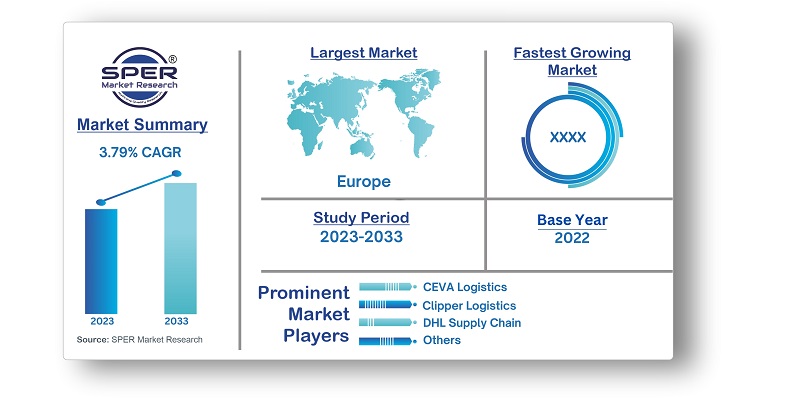
UK Contract Logistics Market Growth, Trends, Size, Demand, Challenges and Fututre Outlook
United Kingdom Contract Logistics Market Size- By Type, By End User - Regional Outlook, Competitive Strategies and Segment Forecast to 2033
| Published: Feb-2024 | Report ID: AMIN2453 | Pages: 1 - 105 | Formats*: |
| Category : Automotive & Transportation | |||
- July 2023: CEVA Logistics expects to transition to 100% low-carbon electricity by 2025 for all of its freight warehouses and contract logistics. A combination of low-carbon electricity purchases from nearby utilities (nuclear and renewable) and increased electricity generation from rooftop solar panels will support the pledge; by 2025, CEVA plans to triple its electricity generation from solar power. By 2023, CEVA also wanted all warehouse facilities to have 100% LED illumination.
- April 2023: Maersk has signed a new lease for 685,000 square feet, or roughly 63,000 square meters, at SEGRO Logistics Park East Midlands Gateway, expanding its network of warehouses throughout the United Kingdom. Currently, A.P. Møller - Maersk A/S runs warehouses in Doncaster, Tamworth, and Kettering, UK.


| Report Metric | Details |
| Market size available for years | 2020-2033 |
| Base year considered | 2023 |
| Forecast period | 2024-2033 |
| Segments covered | By Type, By End User |
| Regions covered | Eastern Region, Southern Region, Northern Region, Western Region |
| Companies Covered | CEVA Logistics, Clipper Logistics, DHL Supply Chain, Eddie Sobert, EV Cargo, FedEx, Rhenus Logistics, UPS, Wincanton, XP Supply Chain, Others. |
- Manufacturers
- Retailers
- E-commerce Companies
- Third-party Logistics Providers
- Freight Forwarders
- Wholesale Distributors
- Pharmaceutical Companies
| By Type: |
|
| By End User: |
|
| By Region: |
|
- United Kingdom Contract Logistics Market Size (FY’2024-FY’2033)
- Overview of United Kingdom Contract Logistics Market
- Segmentation of United Kingdom Contract Logistics Market By Type (Insourced, Outsourced)
- Segmentation of United Kingdom Contract Logistics Market By End User (Manufacturing and Automotive, Consumer Goods and Retail, Pharmaceutics and Healthcare, Hi-tech, Others)
- Expansion Analysis of United Kingdom Contract Logistics Market
- Problems and Obstacles in United Kingdom Contract Logistics Market
- Competitive Landscape in the United Kingdom Contract Logistics Market
- Impact of COVID-19 and Demonetization on United Kingdom Contract Logistics Market
- Details on Current Investment in United Kingdom Contract Logistics Market
- Competitive Analysis of United Kingdom Contract Logistics Market
- Prominent Players in the United Kingdom Contract Logistics Market
- SWOT Analysis of United Kingdom Contract Logistics Market
- United Kingdom Contract Logistics Market Future Outlook and Projections (FY’2024-FY’2033)
- Recommendations from Analyst
1.1. Scope of the report1.2. Market segment analysis
2.1. Research data source2.1.1. Secondary Data2.1.2. Primary Data2.1.3. SPER’s internal database2.1.4. Premium insight from KOL’s2.2. Market size estimation2.2.1. Top-down and Bottom-up approach2.3. Data triangulation
4.1. Driver, Restraint, Opportunity and Challenges analysis4.1.1. Drivers4.1.2. Restraints4.1.3. Opportunities4.1.4. Challenges
4.2. COVID-19 Impacts of the United Kingdom Contract Logistics Market
5.1. SWOT Analysis5.1.1. Strengths5.1.2. Weaknesses5.1.3. Opportunities5.1.4. Threats5.2. PESTEL Analysis5.2.1. Political Landscape5.2.2. Economic Landscape5.2.3. Social Landscape5.2.4. Technological Landscape5.2.5. Environmental Landscape5.2.6. Legal Landscape5.3. PORTER’s Five Forces5.3.1. Bargaining power of suppliers5.3.2. Bargaining power of buyers5.3.3. Threat of Substitute5.3.4. Threat of new entrant5.3.5. Competitive rivalry5.4. Heat Map Analysis
6.1. United Kingdom Contract Logistics Market Manufacturing Base Distribution, Sales Area, Product Type6.2. Mergers & Acquisitions, Partnerships, Product Launch, and Collaboration in United Kingdom Contract Logistics Market
7.1. United Kingdom Contract Logistics Market Value Share and Forecast, By Type, 2024-20337.2. Insourced7.3. Outsourced
8.1. United Kingdom Contract Logistics Market Value Share and Forecast, By End User, 2024-20338.2. Manufacturing and Automotive8.3. Consumer Goods and Retail8.4. Pharmaceutics and Healthcare8.5. Hi-tech8.6. Others
9.1. United Kingdom Contract Logistics Market Size and Market Share
10.1. United Kingdom Contract Logistics Market Size and Market Share By Type (2020-2026)10.2. United Kingdom Contract Logistics Market Size and Market Share By Type (2027-2033)
11.1. United Kingdom Contract Logistics Market Size and Market Share By End User (2020-2026)11.2. United Kingdom Contract Logistics Market Size and Market Share By End User (2027-2033)
12.1. United Kingdom Contract Logistics Market Size and Market Share By Region (2020-2026)12.2. United Kingdom Contract Logistics Market Size and Market Share By Region (2027-2033)12.3. Eastern Region12.4. Southern Region12.5. Northern Region12.6. Western Region
13.1. CEVA Logistics13.1.1. Company details13.1.2. Financial outlook13.1.3. Product summary13.1.4. Recent developments13.2. Clipper Logistics13.2.1. Company details13.2.2. Financial outlook13.2.3. Product summary13.2.4. Recent developments13.3. DHL Supply Chain13.3.1. Company details13.3.2. Financial outlook13.3.3. Product summary13.3.4. Recent developments13.4. Eddie Sobert13.4.1. Company details13.4.2. Financial outlook13.4.3. Product summary13.4.4. Recent developments13.5. EV Cargo13.5.1. Company details13.5.2. Financial outlook13.5.3. Product summary13.5.4. Recent developments13.6. FedEx13.6.1. Company details13.6.2. Financial outlook13.6.3. Product summary13.6.4. Recent developments13.7. Rhenus Logistics13.7.1. Company details13.7.2. Financial outlook13.7.3. Product summary13.7.4. Recent developments13.8. UPS13.8.1. Company details13.8.2. Financial outlook13.8.3. Product summary13.8.4. Recent developments13.9. Wincanton13.9.1. Company details13.9.2. Financial outlook13.9.3. Product summary13.9.4. Recent developments13.10. XP Supply Chain13.10.1. Company details13.10.2. Financial outlook13.10.3. Product summary13.10.4. Recent developments13.11. Others
SPER Market Research’s methodology uses great emphasis on primary research to ensure that the market intelligence insights are up to date, reliable and accurate. Primary interviews are done with players involved in each phase of a supply chain to analyze the market forecasting. The secondary research method is used to help you fully understand how the future markets and the spending patterns look likes.
The report is based on in-depth qualitative and quantitative analysis of the Product Market. The quantitative analysis involves the application of various projection and sampling techniques. The qualitative analysis involves primary interviews, surveys, and vendor briefings. The data gathered as a result of these processes are validated through experts opinion. Our research methodology entails an ideal mixture of primary and secondary initiatives.



Frequently Asked Questions About This Report
PLACE AN ORDER
Year End Discount
Sample Report
Pre-Purchase Inquiry
NEED CUSTOMIZATION?
Request CustomizationCALL OR EMAIL US
100% Secure Payment






Related Reports
Our Global Clients
Our data-driven insights have influenced the strategy of 200+ reputed companies across the globe.




















